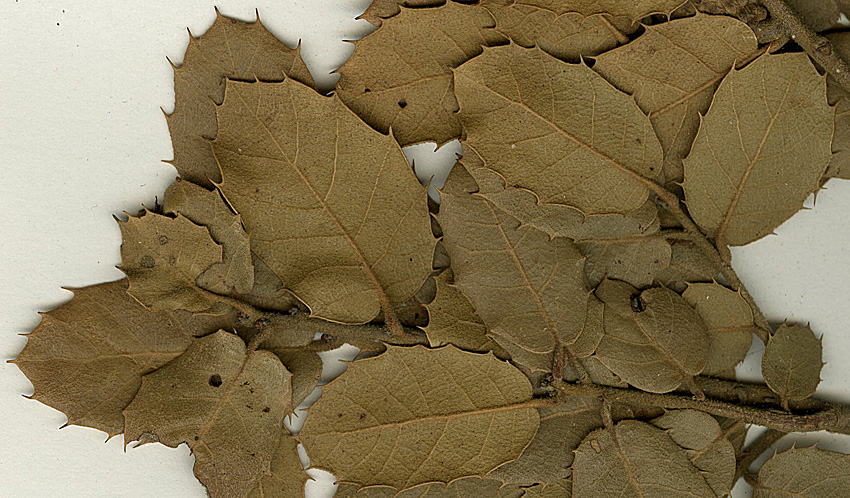| Quercus x auzendei | |
| Author | Gren. & Godron 1855 Fl. France 3: 119 1855. |
| Synonyms | coccifera
x ilex subsp ilex = coccifera var. auzandri (Gren. & Godr.) Jahand. & Maire 1932 = ilex var. agrifolia A.DC = x agrifolia Batt. & Trab. 1890 = x trabutiana Maire 1926 = x aquifolia Trab. 1905 = x catalaunica Sennen 1912 = x airensis Franco & Vasc. 1954 = x comari Albert 1902 = x denudata Albert 1902 = x mestoides Reynier in Albert 1902 = x reynieri Albert 1902 = x soluntina Tineo ex Lojac. 1907 = x rouxii A.Camus 1935 |
| Local names | |
| Range | France, Spain, Portugal, Morocco, Algeria, Sicily, Greece; |
| Growth habit |
small shrub 2 to 10 m, seldom to 15 m; |
| Leaves | evergreen 1.5-2.5 cm x 1.4-2; leathery; oblong-elliptic, dark green above, glaucous tomentose beneath; margin wavy with small mucronate teeth; 5-7 vein pairs; petiole hairy, 3.5 cm; |
| Flowers | |
| Fruits | acorn solitary, on short peduncle, enclosed 1/2 or more by cup; cup with long, pointed, never appressed, slightly pubescent scales; |
|
Bark, twigs and |
bark like one of the parents; twig hairy, erect or drooping, but never divaricated as in coccifera; bud ovoid or subglobose, brown, with persistent bracts; |
| Hardiness zone, habitat | warm, dry, calcareous soils; |
| Miscellaneous |
-- Sometimes erroneously
written : x auzendrei, or x auzandrii; the name comes
from Joseph Auzende, chief-gardener in Toulon, France, so Gren. &
Godr. named the taxon "auzendei" in 1855, which is
currently the good name, despite the fact that they changed this name
to auzandri one year later (1856)...(ICBN Arts 60.1 and 60.11). -- For Vila-Viçosa & al. 2022, Q. x airensis is actually a non-hybrid species (Q. airensis, see this word), close to Q. aucheri. -- The numerous
synonyms given to Q.auzendei are not justified if one regards
Q.ilex as "sensu lato", but considering the numerous
varieties of Q.ilex (and Q.rotundifolia) and the fact
that each variety will give a "different from others" taxon
when hybridized with Q.coccifera, it is understandable that several
authors had described so many species...! (for example, Q.denudata
is the hybrid Q.coccifera X Q.ilex var. denudata,
and so on...) |
| Subspecies and varieties |
|
| Pictures |  |